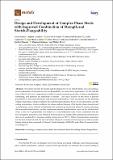Por favor, use este identificador para citar o enlazar a este item:
http://hdl.handle.net/10261/215687COMPARTIR / EXPORTAR:
 SHARE SHARE
 CORE
BASE CORE
BASE
|
|
| Visualizar otros formatos: MARC | Dublin Core | RDF | ORE | MODS | METS | DIDL | DATACITE | |

| Campo DC | Valor | Lengua/Idioma |
|---|---|---|
| dc.contributor.author | Graux, Alexis | - |
| dc.contributor.author | Cazottes, S. | - |
| dc.contributor.author | Castro, David de | - |
| dc.contributor.author | San-Martín, David | - |
| dc.contributor.author | Capdevila, Carlos | - |
| dc.contributor.author | Cabrera, J. M. | - |
| dc.contributor.author | Molas, Sílvia | - |
| dc.contributor.author | Schreiber, Sebastian | - |
| dc.contributor.author | Mirković, Djordje | - |
| dc.contributor.author | Danoix, F. | - |
| dc.contributor.author | Fabrègue, D. | - |
| dc.contributor.author | Perez, Michel | - |
| dc.date.accessioned | 2020-06-30T16:39:41Z | - |
| dc.date.available | 2020-06-30T16:39:41Z | - |
| dc.date.issued | 2020 | - |
| dc.identifier.citation | Metals 10(6): 824 (2020) | - |
| dc.identifier.uri | http://hdl.handle.net/10261/215687 | - |
| dc.description | © 2020 by the authors. | - |
| dc.description.abstract | This study presents the design and development of a hot-rolled bainitic steel, presenting a good combination of strength and stretch-flangeability, for automotive applications. Ti, Nb, and Mo were added in the steel composition in order to control austenite grain sizes, enhance precipitation hardening, and promote the formation of bainite. This study focuses on the effect of process parameters on final microstructures and mechanical properties. These parameters are the finishing rolling temperature, which conditions the austenite microstructure before its decomposition, and the coiling temperature, which conditions the nature and morphology of the ferritic phases transformed. A preliminary study allowed to determine the austenite grain growth behavior during reheating, the recrystallization kinetics, and the continuous cooling transformation curves of the studied steel. Then, a first set of parameters was tested at a semi-industrial scale, which confirmed that the best elongation properties were obtained for homogeneous bainitic lath/granular microstructures, that can be produced by choosing a coiling temperature of 500 ∘C . When choosing those parameters for the final industrial trial, the microstructure obtained consisted of a homogeneous lath/granular bainite mixture that presented a Ultimate Tensile Strength of 830 MPa and a Hole Expansion Ratio exceeding 70%. | - |
| dc.description.sponsorship | The authors gratefully acknowledge the funding received from the European Commission, Research Fund for Coal and Steel, under grant agreement 709803 (NANOFORM). | - |
| dc.language.iso | eng | - |
| dc.publisher | Multidisciplinary Digital Publishing Institute | - |
| dc.relation.isversionof | Publisher's version | - |
| dc.rights | openAccess | - |
| dc.subject | Metallurgy | - |
| dc.subject | Complex phase steels | - |
| dc.subject | Microalloyed steels | - |
| dc.subject | Hot rolling | - |
| dc.subject | Stretch-flangeability | - |
| dc.title | Design and Development of Complex Phase Steels with Improved Combination of Strength and Stretch-Flangeability | - |
| dc.type | artículo | - |
| dc.identifier.doi | 10.3390/met10060824 | - |
| dc.description.peerreviewed | Publisher’s version | - |
| dc.relation.publisherversion | https://doi.org/10.3390/met10060824 | - |
| dc.identifier.e-issn | 2075-4701 | - |
| dc.date.updated | 2020-06-30T16:39:42Z | - |
| dc.rights.license | http://creativecommons.org/licenses/by/4.0/ | - |
| dc.contributor.funder | European Commission | - |
| dc.relation.csic | Sí | - |
| dc.identifier.funder | http://dx.doi.org/10.13039/501100000780 | es_ES |
| dc.type.coar | http://purl.org/coar/resource_type/c_6501 | es_ES |
| item.fulltext | With Fulltext | - |
| item.languageiso639-1 | en | - |
| item.openairecristype | http://purl.org/coar/resource_type/c_18cf | - |
| item.openairetype | artículo | - |
| item.cerifentitytype | Publications | - |
| item.grantfulltext | open | - |
| Aparece en las colecciones: | (CENIM) Artículos | |
Ficheros en este ítem:
| Fichero | Descripción | Tamaño | Formato | |
|---|---|---|---|---|
| Design_Graux_Art2020.pdf | 10,51 MB | Adobe PDF |  Visualizar/Abrir |
CORE Recommender
SCOPUSTM
Citations
9
checked on 17-abr-2024
WEB OF SCIENCETM
Citations
7
checked on 27-feb-2024
Page view(s)
125
checked on 24-abr-2024
Download(s)
212
checked on 24-abr-2024
Google ScholarTM
Check
Altmetric
Altmetric
Este item está licenciado bajo una Licencia Creative Commons

